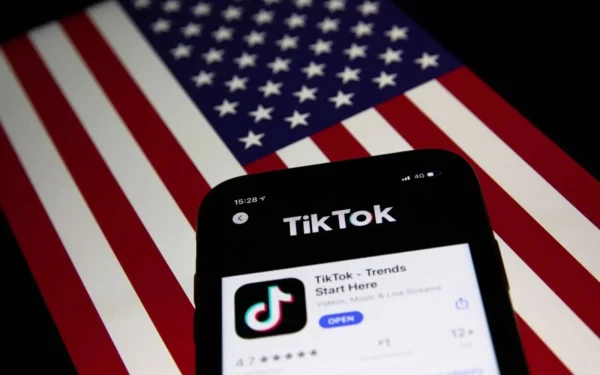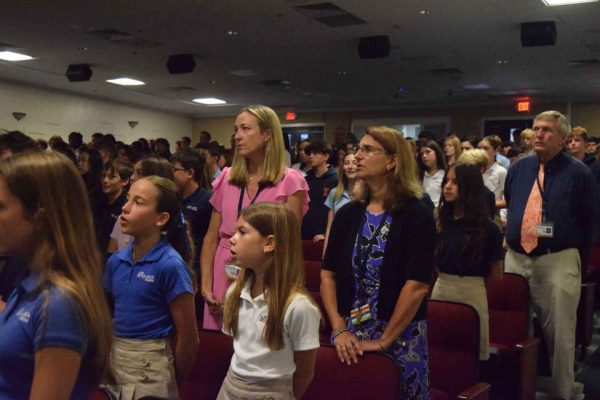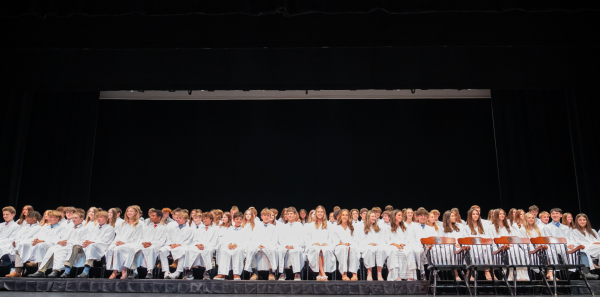Halting Hate – One Student at a Time
Seventh grader Lauren Papa answers a question posed by one of the ADL trainers while classmates Kate Lower (left) and Olivia Cornett look on.
Can one person really make a difference?
The Benjamin School (TBS) definitely thinks so, which is why they invited the Anti-Defamation League (ADL) to campus on August 19 – the third consecutive year TBS has done so.
The ADL spoke to students about bullying and the difference between being an ally (one who stands up for victims), and not a bystander (one who simply allows a bully to be mean and doesn’t get involved). The training is a great time for students to talk frankly about bullying, ask questions, and share personal experiences. and bias, while being with their friends and talking openly.
Originally created “to stop the defamation of the Jewish people and to secure justice and fair treatment to all,” as stated on the organization’s website (adl.org), the ADL now acts to open lines of communication, understanding, and respect among diverse groups while battling all types of bigotry and serving as a resource for government, media, law enforcement, educators and the public. The organization, which began 102 years ago, now has 27 regional offices across the U.S.
The sixth-grade learned about bullying, cyber-bullying, and communication; both verbal and nonverbal. The seventh-grade went into more advanced detail about bullying and bias. Bias is strongly prohibited in most schools, since it is prejudice against a specific person or thing, such as someone being hateful of all African-Americans due to the color of their skin.
In Europe, there is a campaign called the Boycott, Divestment, and Sanctions campaign (BDS). The BDS campaign, initiated by Palestinians, is a “global effort to isolate and punish Israel because of its policies toward the Palestinians,” as stated on adl.org. The ADL calls this campaign, “…a biased effort to demonize Israel and place the entire onus of the conflict on one side: the Israelis.” The BDS is an example of what the ADL believes to be bias
The seventh grade’s training consisted of multiple presentations about bias and bullying, followed by interactive activities about being open. For example, there was a poll given to the students asking them if they had experienced instances of bias and prejudice, whether in their own families, with their friends, or in public.
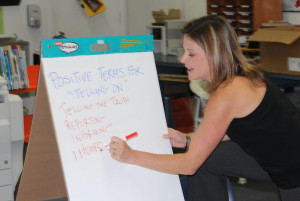
ADL representative Tracey Grossman writes down examples of “telling on,” an alternative to the word “tattling” which has a negative connotation for students. Students are encouraged to “tell on” if they see bullying or behavior that could lead to someone getting hurt at school.
The eighth-grade dug deep into the depths of bullying and microaggressions – the brief, everyday comments that intentionally or unintentionally negatively affect people with underlying messages. The ADL educated the middle school on these microaggressions by providing examples and noting that bullying can unfortunately lead to acts of violence.
The point of this training, as stated in the seventh-grade presentation given by ADL presenter Tracey Grossman, is “[to give students the ability] to recognize bias within the school and to prevent defaming of others.”
The eighth-grade presenter, ADL representative Doug Cureton, further commented, “We know [prejudice and bias] happens, and we’re going to start the first week and tell students this is not what we believe, and we want to front load them for success, to give them the tools and some of the skills they need to practice to stop it whenever they can.”
Hagy said that a few years ago, when kids began getting bullied more and more, he knew he had to do something. He also stated, “It is my obligation to keep students safe, and we [faculty] have a commitment to the physical, emotional, and social safety of the students.”
He further explained that bullying disrupts the school’s academic culture. “[The students] can’t do good when they’re experiencing bullying. A kind, supportive environment is most conducive to learning at this [middle school] age.”
Hagy said that he searched for a program to help the school, and found the ADL. “Their programs for middle school students do the types of things that match our ten core values,” he further commented.
Although some students may agree that the training “…was a bit too long,” as stated by eighth grader Leslie Berg, there is scientific proof that these trainings work. “The University of Pennsylvania actually did track some of our programs since the mid [19]80’s and there is a definite correlation between people appreciating each other’s differences and working together more authentically,” Cureton explained. Seventh grader Michelle Pfeifer agreed that the training was a bit long, but said, “I learned about bullying a lot and it was fun doing [interactive] activities.”
And while some may scoff at Benjamin’s efforts as a mere exercise to appease parents so the administration can say it has addressed bullying, TBS takes the training seriously and wants to cultivate a culture of kindness and empathy amongst its students. Furthermore, the consequences of such trainings may have more far-reaching effects than simply kids being nice to one another.
For example, according to the ADL’s website, every year, the organization travels with American law enforcement to Israel for a seminar on terrorism. One of Israel’s greatest international threats is ISIS (or ISIL). This Islamic fundamentalist terrorist group which is based in Iraq and Syria, has been accused by the United Nations of carrying out human rights abuses, war crimes, and ethnic cleansing. American soldiers fighting the war on terror act as allies against the ISIS terrorists (essentially, deadly bullies equipped with guns and explosives) as they try to take down ISIS and stop the threat of global terrorism.
The long list of terrorist acts over the past 15 years can be linked to hatred, fear, intolerance, and an unquenchable desire for power – the same traits many school bullies possess. The 9/11 attacks, the Boston Marathon bombing, the shooting at Charlie Hebdo, the Charleston Emanuel African Methodist Episcopal Church shootings, and the recently thwarted terrorist attack on a French train are all illustrations of the great cost of hate and lack of empathy.
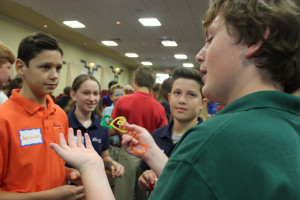
Eighth grader Michael Yancey explains his pipe cleaner configuration to fellow eighth graders (left to right) Alex Wolff, Leslie Berg, and Joey Berg.
It may seem far-fetched to draw such dramatic parallels between schoolyard bullies and deadly terrorists, but there is a correlation according to a 2003 study by the U.S. Department of Health and Human Services. In that study, researchers found that kids who bully or are bullied are more likely to be involved in violent behavior. In addition, the study reported that violence-related behaviors were more common in victims of bullying than people who have never been bullied. So it’s just not the bullies that may continue to be violent, but their victims as well.
Yes, the ADL teaches the The Benjamin Middle School about bullying so that the microaggressions and name calling will not happen at TBS, but the ADL and TBS administration also hope that the students will take that education with them out into the world. That way, the terrorism and hate crimes that seem to be 24-hour running headlines will come to an end.
So, the importance of the ADL Training may be overlooked by some, but in fact, it is not only a vital part of the entire school year, but may influence a lifetime of choices. “We need to spread the message that no one should bully,” said sixth grader Eden Josza. It’s a simple message, but one that has the potential to have far-reaching effects beyond the walls of Benjamin.

